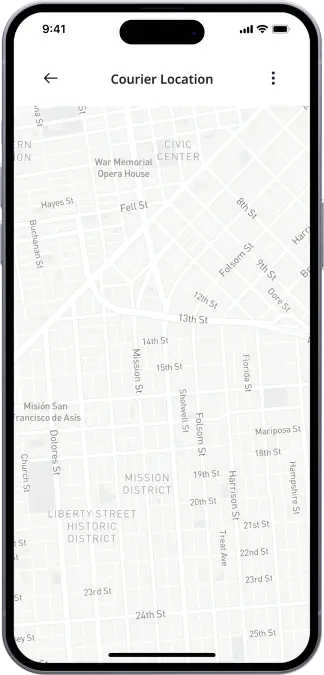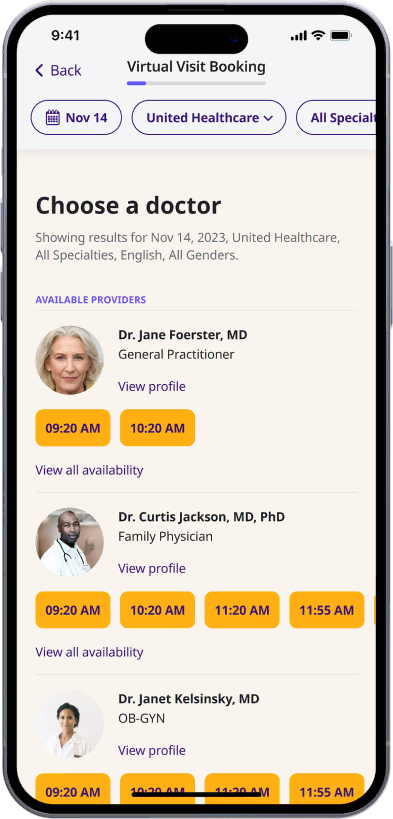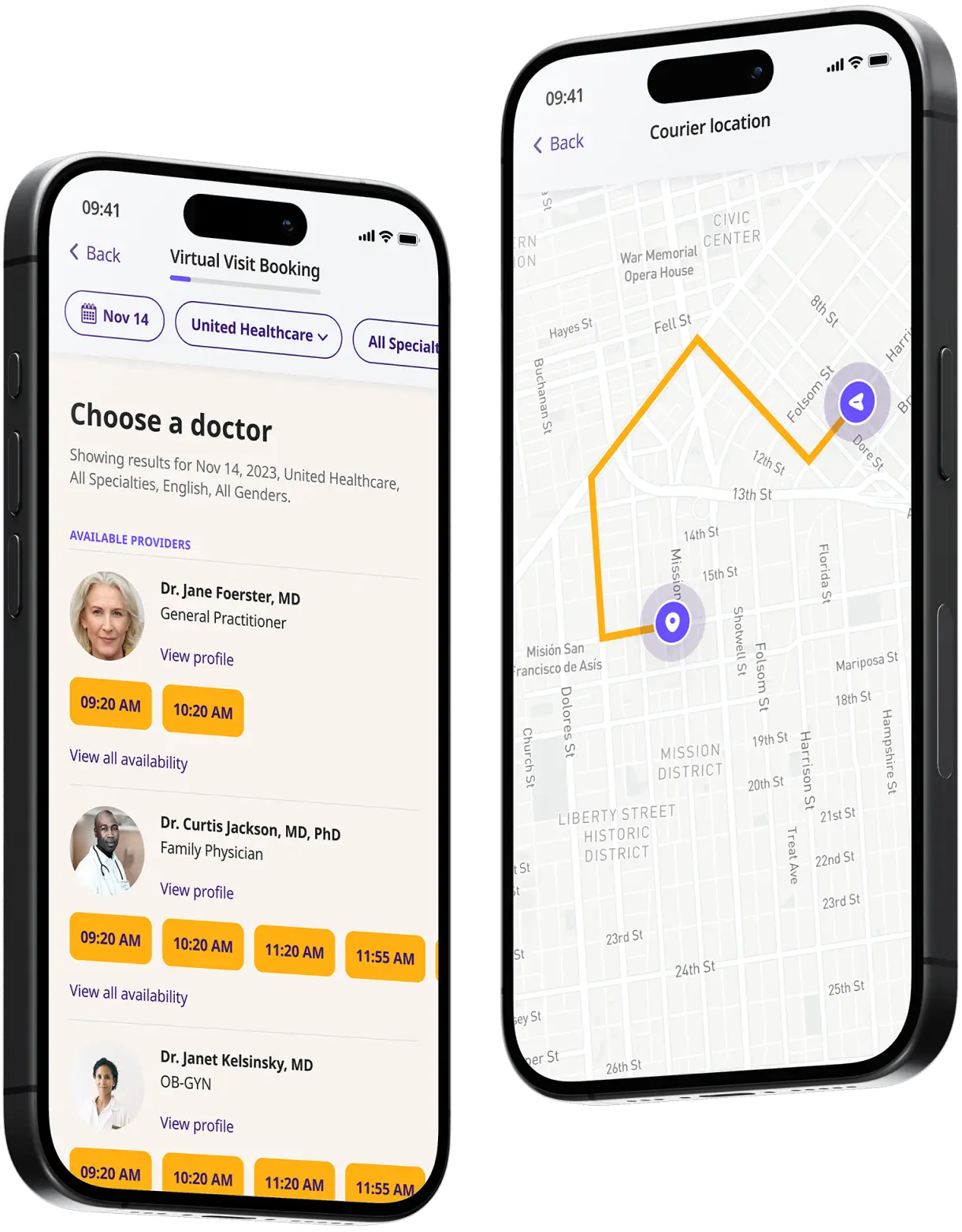Get a Cymbalta Prescription Online (Duloxetine)
Get a new Cymbalta (duloxetine) prescription or refill your medication online.


Available in 50 states. Insurance accepted.
Fast
virtual visits
24/7 care
assistants
Prescriptions
as needed



See If Delivery Is Available Near You
Delivery Not Available
Enter your ZIP code to check if prescription delivery is available in your area and how soon your meds could arrive.
How to get started
Choose your doctor, start a virtual visit, and have your prescriptions sent to your preferred pharmacy for pickup — all in just a few easy steps.
Choose a doctor
Choose a physician by availability, specialty, ratings, and more.

Start a video call
Get connected with a doctor anytime, anywhere.

1-Hour Rx Delivery
Your prescription delivered to your door in 1 hour or less.

Available in 50 states. Insurance accepted.
One-Time
Physician Visit
One-time visit with a physician for diagnosis, treatment, Rx, labs, referrals, and doctor’s notes.
Accepted Insurances
See why people turn to DrHouse...
As seen in

Cymbalta (Duloxetine)
Cymbalta, also known as duloxetine hydrochloride, is a type of antidepressant known as a serotonin-norepinephrine reuptake inhibitor (SNRI). It comes in the form of a pill or capsule that is swallowed whole. Cymbalta has the potential to help improve a variety of symptoms associated with depression, such as an individual’s disposition, appetite, sleep, and energy levels.
The reuptake of the neurotransmitters serotonin and norepinephrine in the central nervous system can be inhibited by duloxetine because it is an SNRI. This increases the amount of these neurotransmitters that are available in the brain. Because of these brain chemicals’ role in helping to regulate mood, elevating their levels can be an effective treatment for depression.
What is Cymbalta Prescribed For?
Cymbalta is prescribed to patients suffering from major depressive disorder as a treatment option. In clinical trials, the efficacy of Cymbalta for longer-term use, which is defined as use lasting more than nine weeks, has not been systematically evaluated. In addition, it is utilized in the treatment of diabetic peripheral neuropathic pain, generalized anxiety disorder, fibromyalgia, and chronic musculoskeletal pain.
Off-label uses of Cymbalta include the treatment of stress urinary incontinence, chronic fatigue syndrome, and lower back pain.
How Does Cymbalta Work?
The reuptake of serotonin and norepinephrine in the central nervous system can be blocked by the medication Cymbalta. It does this by acting on dopamine reuptake pumps, which results in an increase in the amount of dopamine that is able to diffuse throughout the brain. In addition to this, it raises levels of anti-inflammatory cytokines and lowers levels of pro-inflammatory cytokines, both of which contribute to the alleviation of depressive symptoms. It is believed that the blocking of sodium channels is the mechanism responsible for the analgesic effects of this medication.
What Are the Side Effects of Cymbalta?
Symptoms such as a headache, nausea, diarrhea, dry mouth, decreased appetite, increased perspiration, feeling nervous, restless, fatigued, sleepy, or unable to sleep may be caused by Cymbalta. As long as you keep taking the medication as prescribed, you should notice an improvement in these symptoms within the first week or two.
Sexual side effects, such as difficulties with orgasm or ejaculatory delay, as well as increases in blood pressure, frequently do not improve with continued use of the medication.
Duloxetine has been linked to extremely rare cases of liver failure, which has on occasion, been fatal. Those who have heavy alcohol use or chronic liver disease are at a greater risk for developing this condition.
Patients who took duloxetine sometimes experienced orthostatic hypotension, which refers to a drop in blood pressure when the patient stood up or got out of bed after sleeping. Patients who are also taking medication to treat their high blood pressure may be at an increased risk.
Antidepressants known as SNRIs, such as duloxetine, have been linked to an increased risk of bleeding events. This may include gums that bleed more easily, nosebleeds, or bleeding from the digestive tract or gastrointestinal tract.
Frequently Asked Questions About Cymbalta (Duloxetine)
How to Use Cymbalta?
You should take this medication orally as directed by your physician, which is typically once or twice daily, regardless of whether you take it with or without food. If you are experiencing nausea, taking this medication with food may be of assistance. Take the capsule as directed and completely. You should not chew the capsule, crush it, or mix its contents with food or liquid in any way. This can cause the drug to be released all at once, which raises the risk of experiencing adverse effects.
What to Avoid While Using Cymbalta?
While you are taking antidepressant medication, it is important that you abstain from drinking alcohol and using illegal drugs. They have the potential to lessen the positive effects of the medication (such as making your condition worse) and increase the negative effects (such as sedation). Consuming alcohol while taking duloxetine raises the likelihood of developing liver problems.
Can You Get Cymbalta Over-The-Counter (OTC)?
No, Cymbalta (duloxetine) is not available over-the-counter and can only be obtained with a prescription from a licensed physician.
Can You Get a Duloxetine Prescription Online?
Yes, you can receive an online prescription for Duloxetine (Cymbalta) through DrHouse after a virtual consultation with our licensed physicians. They will review your medical history and current condition to determine if Duloxetine is the best course of treatment for you.
For more detailed information about Cymbalta (Duloxetine), you can refer to the following sources:
- Cymbalta prescription label, Food and Drug Administration (FDA).
- Cymbalta, Drugs.com.
- Duloxetine, MedlinePlus.
- Duloxetine, U.S. National Library of Medicine.
The content on this page has been medically reviewed for accuracy and comprehensiveness by Amy Dougherty, FNP-BC, AGAC
Related services
Explore more of our services tailored to your needs and discover additional ways we can support your healthcare needs.
Frequently asked questions



